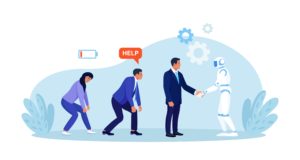It’s 8 a.m., and you’ve just sat down at your desk, ready to dive into the mountain of work ahead. You’re a research analyst, an investment banker, or a consultant, and the task for the day is to sift through stacks of documents, reports, and industry data. Hours go by, as you manually piece together spreadsheets and presentations, conduct your research, and scramble to draw insights from the overwhelming influx of information. Sound familiar?
The traditional office landscape, particularly in research-based and investment-driven professions, has remained largely stagnant despite the technological boom. The pressure to deliver faster insights and recommendations is higher than ever, yet manual research processes persist, sucking up valuable hours—hours that could be spent on high-level tasks like analysis, strategy, and client interaction. The inefficiency of these processes doesn’t just cost time; it costs real money, burns people out, and inhibits innovation.
The Cost of Manual Research
Let’s quantify just how much time is wasted in these environments. The McKinsey Global Institute estimates that employees in highly skilled professions—particularly those in knowledge-intensive jobs such as investment research, consulting, and law—spend, on average, 20% of their working week looking for internal information or tracking down data. This means that one full day of work per week, or 52 days a year, is consumed by menial, low-value tasks.
The numbers don’t stop there. A study by IDC, commissioned by OpenText, found that document-related challenges—including searching for information, recreating lost documents, and other inefficiencies—account for nearly 21.3% of organizational productivity losses. When you’re talking about professionals earning six-figure salaries, this is not just an inconvenience; it’s a significant financial drain.
In investment jobs, like those at hedge funds or equity research firms, this inefficiency has an even greater impact. Imagine a scenario where an analyst is tasked with analyzing a competitor’s earnings report. This person may spend hours—if not days—pulling numbers from PDFs, manually entering data into spreadsheets, and cross-referencing it with other reports. Meanwhile, the client waits, and the market moves. The inefficiency not only delays decision-making but risks missing critical windows of opportunity.
Enter AI: The Productivity Hero We’ve Been Waiting For
The solution to this overwhelming inefficiency lies in the one place where so many fear disruption: technology, and more specifically, artificial intelligence (AI). AI is not just the next buzzword in Silicon Valley; it’s already proving its worth in saving time, reducing costs, and providing actionable insights faster than ever.
Take, for example, AlphaSense, an AI-powered financial search engine designed to cut research time in half. Instead of manually combing through hundreds of financial reports, earnings calls, and press releases, an analyst can now use AlphaSense to scan the text for specific trends or terms and receive instant insights. What used to take hours can now be accomplished in minutes, freeing up professionals to spend time on more critical, value-added tasks such as interpreting the data and building investment theses.
Similarly, Kensho, acquired by S&P Global in 2018 for a reported $550 million, uses machine learning and natural language processing (NLP) to process unstructured data such as news articles, social media feeds, and reports. Kensho is designed to help analysts predict market trends by analyzing vast amounts of information that would be impossible for any single human to process in a timely manner. What was once the laborious task of tracking down and synthesizing information has now become a streamlined, automated process.
Another game-changer is Sentieo, a research platform that combines AI, NLP, and financial data analytics. Sentieo’s AI tools can read, extract, and summarize insights from earnings reports, regulatory filings, and other documents, allowing financial analysts to focus on analysis rather than manual data entry. According to a Forrester Consulting study commissioned by Sentieo, companies that adopted their platform saw a reduction in time spent on manual data aggregation by 50%, leading to improved productivity and faster decision-making.
The Time, Cost, and Human Benefits
So, how much time and money can be saved by these AI-driven tools? A study by Accenture found that companies adopting AI technologies in professional services could boost productivity by up to 40%. In financial services alone, AI could save the industry $1 trillion by 2030 by automating tedious, data-heavy tasks and enhancing decision-making processes. This isn’t science fiction—this is a future that is already happening.
On a more granular level, companies can realize enormous savings simply by reducing the hours spent on manual data entry and research. If the average financial analyst or consultant earns 100,000annually,andthey’rewasting20100,000annually,andthey’rewasting2020,000 per employee, per year, in lost productivity. Multiply that across a mid-sized firm of 1,000 employees, and you’re talking about a $20 million problem. AI tools that help professionals reclaim even half of this wasted time represent a direct, quantifiable return on investment (ROI).
Now imagine what happens to the human side of this equation. Professionals in research-intensive jobs are often at risk of burnout, particularly when they’re bogged down by tedious, repetitive tasks that drain their mental energy. According to Gallup, employees who experience burnout are 63% more likely to take a sick day, and 2.6 times more likely to be actively seeking another job. By leveraging AI to handle these low-value tasks, companies not only increase output but also reduce employee turnover, improve morale, and allow their talent to focus on more engaging, higher-order work.
Regaining Free Time: The Ultimate Luxury
Perhaps the most undervalued benefit of AI in the workplace is the gift of time. For decades, technology has promised to make our lives easier, but often, it seems to do the opposite. Emails flood our inboxes, alerts ping us at all hours, and tasks multiply faster than we can complete them. However, AI, when implemented thoughtfully, actually has the potential to fulfill the promise of freeing us from the grind.
Consider a scenario where investment bankers no longer spend 10 hours a week manually inputting data or searching for financial documents, but instead use that time for creative thinking, strategic planning, or simply having a lunch break—something that has become a luxury in the fast-paced world of finance. Professionals across sectors could finally spend more time on the things that matter—whether it’s career development, mentorship, or regaining work-life balance.
And the future could get even better. Imagine an AI assistant so advanced that it can perform the initial stages of a research project—gathering data, analyzing sources, generating reports—while you sleep. You wake up to find the bulk of your research already done, ready for you to add the finishing touches and make informed decisions. That’s not far from the world we’re heading towards, with tools like IBM Watson and Google AI already pushing the boundaries of what’s possible.
The Fear of Obsolescence Is a False Choice
The resistance to embracing AI in professional services often stems from fear: the fear of being replaced, the fear of change, the fear that we’ll all become obsolete. But this fear is unfounded. Gartner predicts that AI will create more jobs than it eliminates by 2025, particularly in fields that require strategic thinking, problem-solving, and creativity. AI will never replace the nuanced understanding that human professionals bring to the table. It will merely augment it, allowing us to operate at a higher level than we’ve ever thought possible.
In fact, the integration of AI can serve as an intellectual renaissance in the workplace. Just as the personal computer revolutionized office work in the 1980s, AI promises to usher in a new era where professionals spend less time on the minutiae and more time innovating, strategizing, and engaging with clients.
Conclusion: The Office Revolution Has Begun
We stand on the precipice of a profound shift in how research-based and investment jobs function. The inefficiencies that have long plagued these industries—inefficiencies that cost billions in lost productivity—are being systematically dismantled by AI and technology-driven tools. The time saved will lead not only to increased profits but to a more engaged, fulfilled workforce.
It’s time to embrace AI, not as a replacement for human workers but as a powerful tool to enhance our capabilities, streamline our processes, and free us from the drudgery of manual tasks. The office of the future isn’t one where humans are made obsolete—it’s one where we’re finally able to do our best, most creative work.




